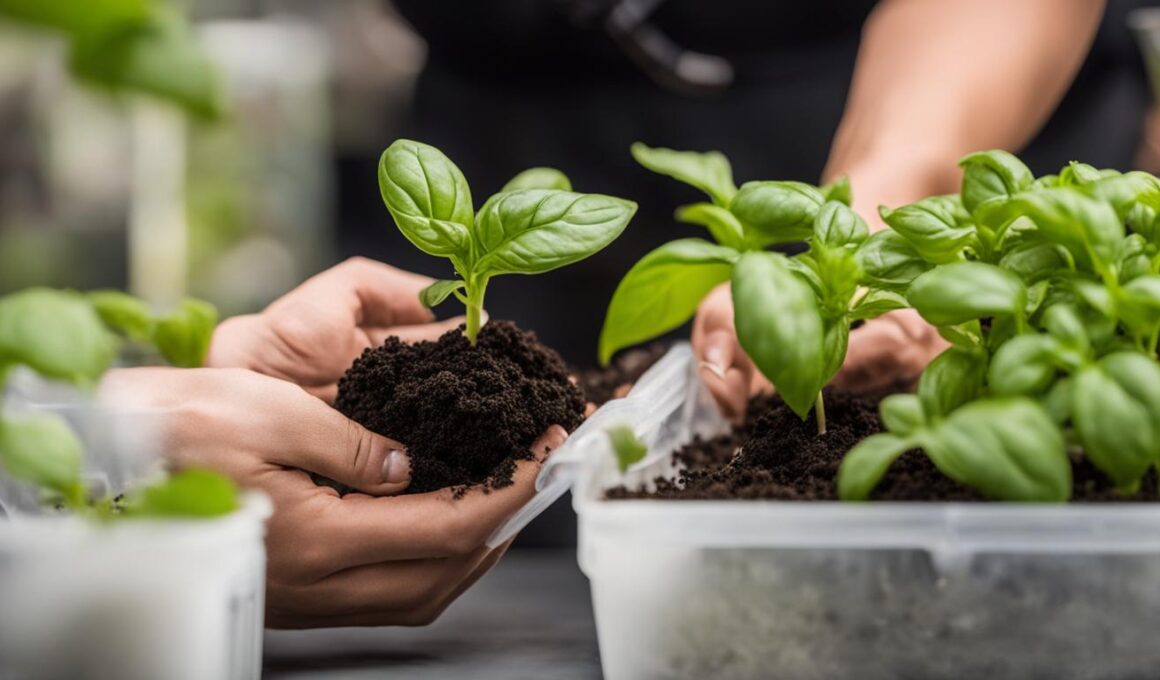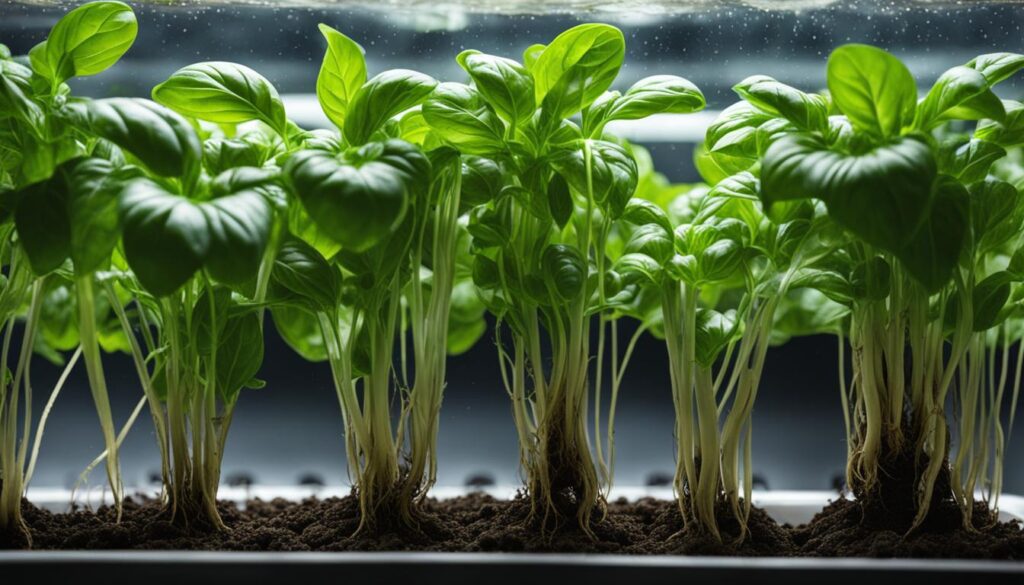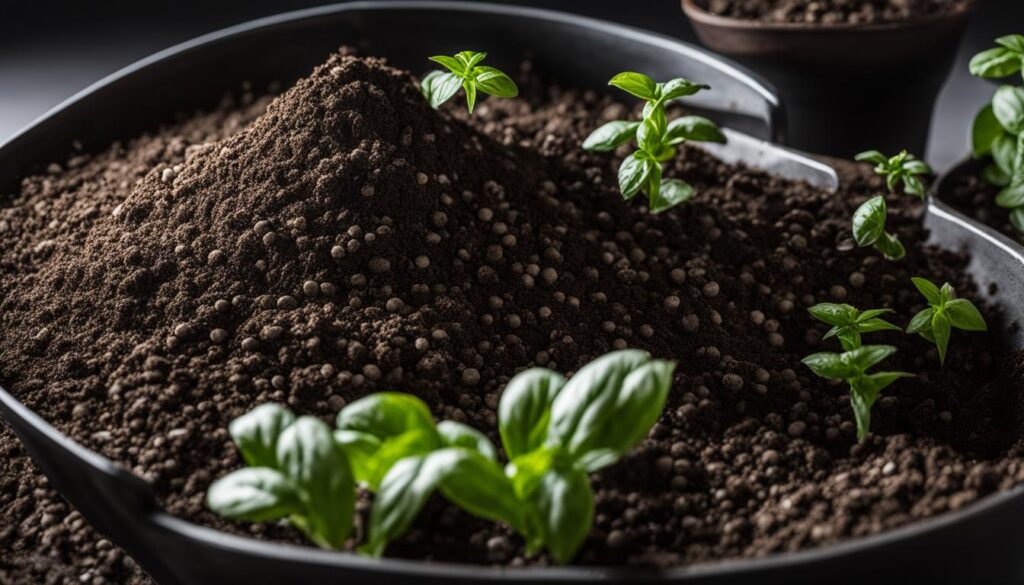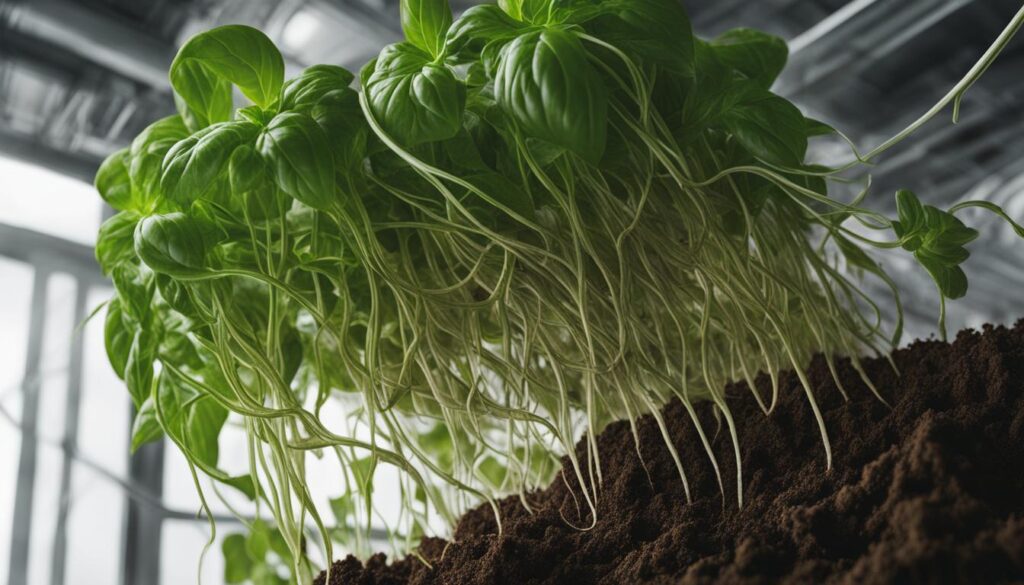If you’ve ever come across fresh hydroponic basil at your local grocery store or farmers market, you may have wondered if it’s possible to transplant this soil-free herb into soil and continue growing it. The answer? Yes! With proper care and attention, you can successfully replant hydroponic herbs like basil and enable them to thrive in soil. In fact, making the soil transition with certain varieties, such as Sweet Basil from India, can lead to years of sustainable growth. Of course, root acclimation and the risk of transplant shock can present challenges, but by following the correct methods and utilizing natural growth hormones like Azos and Mykos, you can efficiently grow basil in soil from hydroponics.
Key Takeaways
- Hydroponic basil can be successfully transplanted into soil
- Certain varieties, like Sweet Basil, thrive in soil with proper care
- Root acclimation and transplant shock are challenges to consider
- Natural growth hormones like Azos and Mykos can aid in the transition
- Proper care and attention can lead to years of sustainable basil growth
Understanding Hydroponic Basil’s Journey from Water to Earth
Hydroponic basil, when moved from an aqueous environment to soil, encounters a drastically different growing medium. A successful water to soil transplant requires mindful adaptation of the roots and delicate handling of the plant. The hydroponic to soil journey may prompt stress in the plant, attributable to changes in support, nutrient delivery, and aeration. To facilitate a smooth hydroponic basil transition, it is crucial to prepare the plant for the significant change in environmental conditions and growing mediums.
Several factors influence the success of a hydroponic basil transition:
- Root adaptation
- Nutrient availability
- Soil aeration
- Moisture management
- Plant support
- Acclimation to new conditions
Basil plants may exhibit signs of stress during the hydroponic to soil journey, which can affect their growth and health. Identifying and addressing these stress factors is crucial to ensure a successful transition. You can refer to the following table to recognize common symptoms of stress and the appropriate action to take:
| Stress Symptom | Possible Cause | Recommended Action |
|---|---|---|
| Wilting | Insufficient water or overwatering | Adjust watering schedule and check for proper drainage |
| Yellowing leaves | Nutrient deficiency or excess nutrients | Check soil nutrient levels and adjust fertilization accordingly |
| Stunted growth | Root issues, poor soil aeration, or inadequate nutrients | Examine root health, improve soil aeration, and/or amend soil with appropriate nutrients |
| Weak stems | Lack of physical support or insufficient light | Provide physical support and ensure optimal light conditions |
Understanding the challenges faced by hydroponic basil during its journey from water to earth helps in taking the necessary measures to ensure a successful transplant. By providing proper plant support, adequate nutrients, well-aerated soil, and carefully managing moisture levels, your basil plant will successfully make the transition from a hydroponic to a soil environment.
Preparing for a Successful Soil Transition
Setting up the right conditions for hydroponic basil to thrive in its new soil environment is critical to ensuring a smooth and successful transition. This involves selecting an appropriate soil mix, acclimating the basil plant to its new environment, and choosing the optimal timing for the transplant.
Choosing the Right Soil Composition
When it comes to soil selection for basil, choosing an appropriate soil mix for hydroponic basil is essential to support the plant’s new growing conditions. To create a rich, well-draining potting mix, consider combining:
- Organic gardening soil
- Compost or composted manure
- Perlite or vermiculite for improved drainage
This mix will help ensure that the soil has the right balance of nutrients and drainage required for your basil plant to flourish.
Acclimating Hydroponic Basil to New Conditions
Before transplanting, it is crucial to acclimate basil plants by gradually introducing them to the conditions they will face in soil. This process, known as basil soil acclimation, involves:
- Gradually increasing sunlight exposure
- Introducing the plant to outdoor temperatures and airflow
- Adjusting watering schedules to mimic soil conditions
Taking these steps will help strengthen the basil plant’s adaptability and resilience, making it more capable of enduring the stress brought on by the soil transition.
When to Transplant for Optimal Growth
The best time to transplant basil is a crucial factor in ensuring a successful transition. The optimal transplant timing for basil is when the plant reaches a few inches in height or has at least two or three sets of true leaves. This development stage ensures that the basil plant is mature enough to endure the stress of the transition and establish itself in its new soil environment.
Navigating the Challenges of Root Adaptation
When transplanting hydroponic basil to soil, the basil root adaptation process plays a crucial role in the success of the transition. Basil roots, which are used to the hydroponic system, will need to adjust to the new growing conditions by managing moisture levels and establishing a durable connection to the earth. Overcoming root transition challenges begins by understanding the necessary care and precautions that will be needed during the process.
- Trimming unhealthy roots: Before transplanting, inspect the roots and remove any brown, mushy, or damaged areas. This step prevents further deterioration and encourages the growth of new healthy roots.
- Ensuring proper soil drainage: Choose a well-draining soil mix and a container with drainage holes. This helps to prevent waterlogging, which can lead to root rot and, ultimately, plant failure.
- Monitoring moisture levels: Avoid over-watering by allowing the top inch of soil to dry between waterings. Consistently checking the moisture levels will help to maintain a healthy environment for the basil roots.
Another essential aspect of the transition is establishing a strong root system in the new medium. A robust root system will allow adequate nutrient uptake, enhancing the overall health and growth of your basil plant. The table below outlines effective methods to promote root development after transplanting:
| Method | Description |
|---|---|
| Application of rooting hormone | Applying a commercial or natural rooting hormone, such as Azos or Mykos, to the roots before transplanting can encourage faster root development and adaptation. |
| Aeration of soil | Loosening the soil, using sand or perlite in the soil mix, or employing smart pots will help to improve soil aeration, promoting better oxygen absorption by the roots. |
| Mulching | Adding a layer of mulch around the base of the plant can help regulate soil temperature and retain moisture levels, supporting optimal root development. |
By following these guidelines, you can successfully navigate the challenges of basil root adaptation and guide your hydroponic basil through a smooth transition to soil-grown conditions, resulting in a healthy and flourishing plant.
Replanting Techniques for Hydroponic Basil
A carefully planned and executed soil transfer can lead to a thriving basil plant that originated in a hydroponic system. In this replanting hydroponic basil guide, we provide a step-by-step approach to successfully accomplish the hydroponic basil soil transfer. Following these steps will ensure minimal stress to your basil plant while encouraging robust growth and adaptation to its new environment.
Step-by-Step Guide for Transferring to Soil
- Careful removal of basil from the hydroponic system: Begin by gently detaching the basil plant from the hydroponic system. It is crucial to avoid damaging the roots in the process, as fragile root systems can lead to transplant shock.
- Loosening the growing medium: Remove any remaining hydroponic growing medium from the plant’s roots by gently shaking it off or rinsing with lukewarm water, taking care not to damage the root structure.
- Trimming overgrown roots: With a clean pair of pruning shears or scissors, trim away any overgrown roots, leaving only healthy, white roots to promote efficient nutrient uptake in the new growing medium.
- Preparing the new soil: Select a well-draining potting mix with added organic matter as the ideal soil for hydroponic basil transfer. Moisten the soil before transplanting to ensure sufficient hydration and support the root system.
- Transplanting the basil: Place the basil plant in a prepared container with the moistened soil, positioning it at the same depth it was growing in the hydroponic system. Gently set the roots while backfilling with soil to maintain stability.
- Watering with a rooting hormone solution: After transplanting, water the basil plant with a rooting hormone solution, such as Azos or Mykos, to promote robust root development and facilitate the adaptation process.
By following these hydroponic basil soil transfer steps, you increase the chances of your basil plant’s successful adaptation to its new environment. Keep in mind that the transition might be stressful for your plant, making it vital to provide proper care during and after the transfer process. Allowing time for the basil plant to adjust and establish its roots will ultimately lead to a thriving, lush basil plant that you can enjoy for years to come.
Maintaining Healthy Basil Post-Transplant
After transplanting your hydroponic basil in soil, it is essential to provide the proper care and attention to maintain the health of the plant. This includes efficient watering techniques and delivering key nutrients for its growth.
Watering Strategies for Newly Soiled Basil
The first few weeks after transplanting require attentive watering hydroponic basil in soil to support its transition. Excess water should be avoided, as waterlogging can lead to root rot and other issues. As the plant establishes itself and adapts to the new environment, gradually reduce the watering frequency. An effective soil basil watering technique to employ during this transition period is:
- Water the plant thoroughly at transplant to moisten the soil.
- Keep the soil moist, but not waterlogged, until the basil establishes its roots and shows signs of growth.
- Gradually decrease the watering frequency as the plant acclimates to soil, allowing the top inch of soil to dry out between waterings.
The Role of Nutrients in Supporting Soil-Grown Basil
Providing the right balance of nutrients is pivotal for supporting soil-grown basil. Nitrogen, calcium, and potassium play a major role in the plant’s optimum growth and overall health. Following transplant, it is important to initially avoid fertilization. This allows the basil to establish its new root system in the soil without too much external interference. Once the plant has settled, reintroduce nutrients in a gradual manner.
| Nutrient | Significance for Basil |
|---|---|
| Nitrogen | Encourages vigorous leaf growth and development. |
| Calcium | Supports and strengthens cell walls, vital for the overall health and durability of the plant. |
| Potassium | Assists in root growth, water and nutrient absorption, and disease resistance. |
Fertilizing the basil by following a post-transplant schedule can help it acclimate to its new soil surroundings. Begin with a lighter application of fertilizer (ideally an organic blend), and gradually increase the amount as the basil exhibits healthy growth. This approach will contribute to your basil plant’s successful transition from hydroponics to soil, ensuring a thriving and flourishing herb for your culinary enjoyment.
Is it possible to grow hydroponic basil and dill together in soil?
Yes, it is possible to grow hydroponic basil and dill together. Both herbs have similar growing requirements and can thrive in the same environment. Just make sure to provide ample water, nutrients, and adequate spacing for each plant to ensure successful growing basil and dill together.
Conclusion
In summary, achieving successful hydroponic basil soil growth is possible with the right approach and careful considerations. It begins with understanding the significant environmental changes involved in transitioning from water to soil and preparing both the plant and growing medium accordingly.
By focusing on factors such as selecting the appropriate soil composition, acclimating the plant to its new environment, and implementing proper replanting techniques, the potential risks associated with root adaptation can be minimized. Proper post-transplant care, including watering strategies and nutrient management, is crucial to ensure that your soil-transplanted basil flourishes.
With meticulous planning, execution, and attention to detail, your hydroponic basil can transition smoothly from water to soil, resulting in a thriving and sustainable herb that you can enjoy for years to come. Let these final thoughts on soil-transplanted basil guide you in your gardening journey and contribute to your ongoing success in cultivating basil at home.












